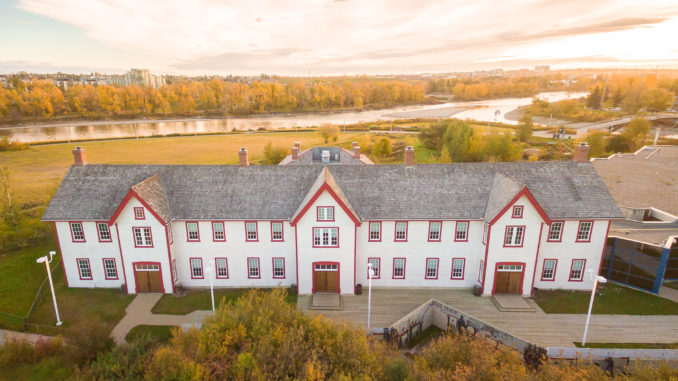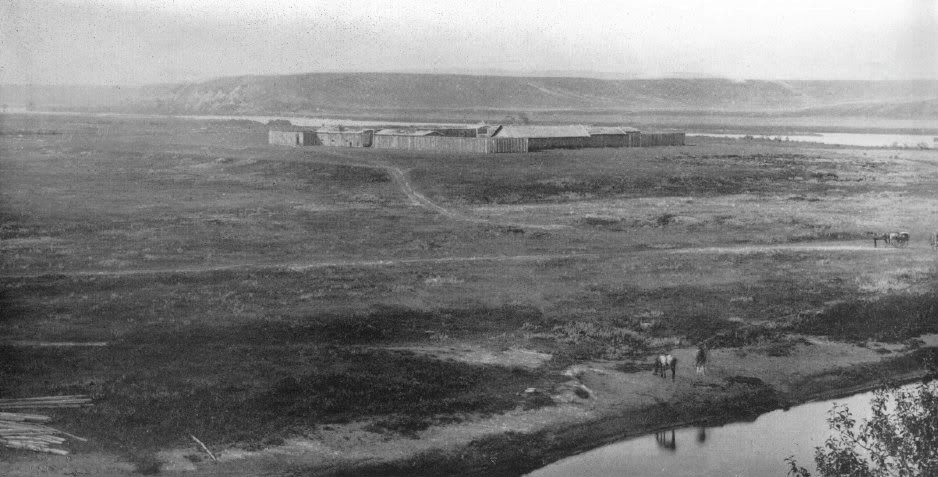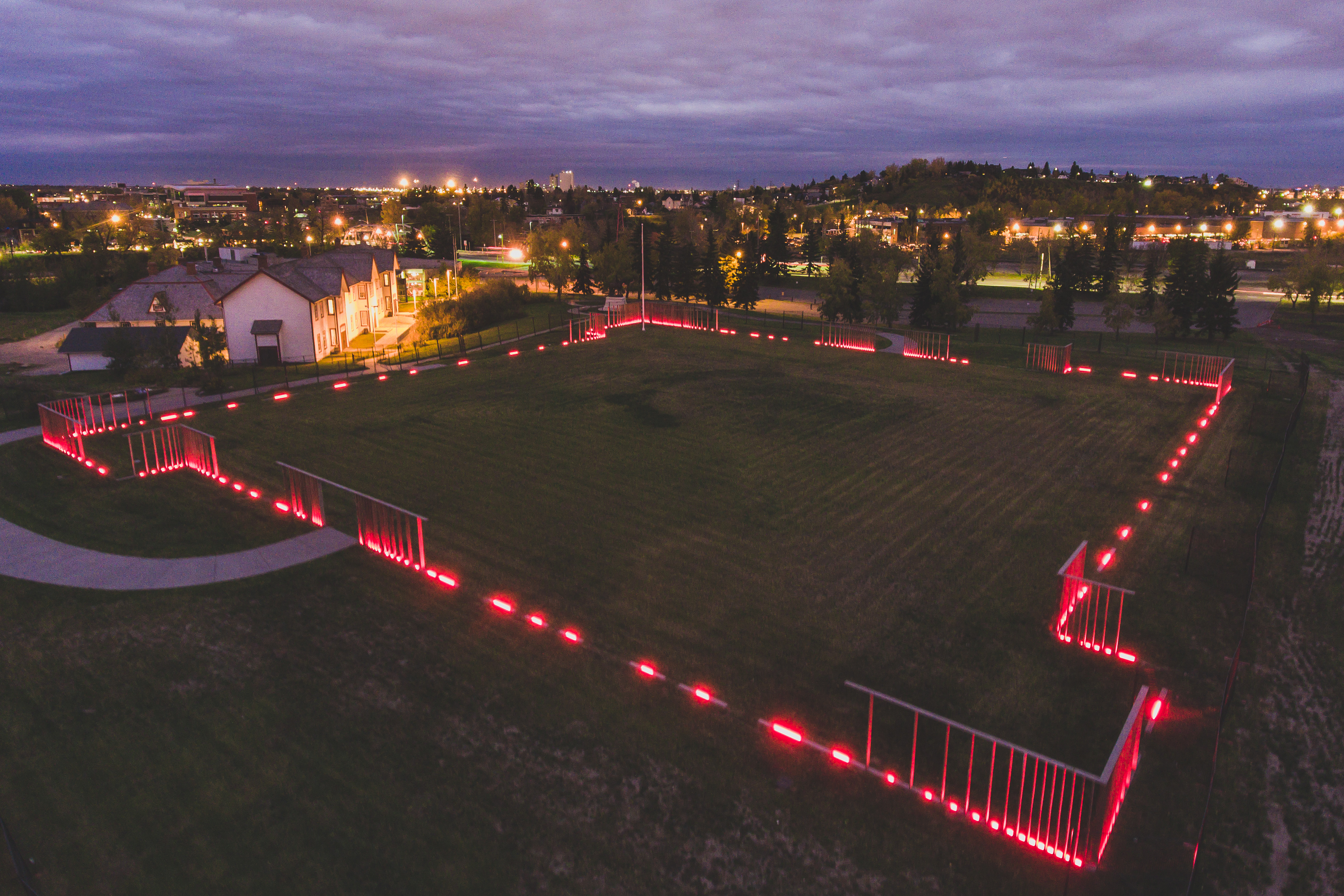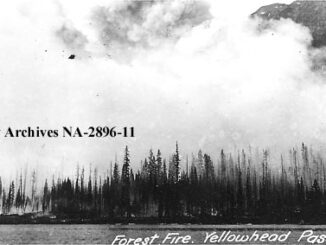
What was it like to stand in the middle of a wide open prairie and imagine a city?
~Inscription on Mountie statue overlooking Fort Calgary.
The confluence of the Bow and Elbow Rivers is a culturally significant place that lies at the heart of traditional Blackfoot territory. Known as Moh’Kinsstis to the Blackfoot people the confluence has special meaning for the bands of the Blackfoot Confederacy. According to legend the confluence is the place where Napi created people, tracing history to the the roots of humanity itself. Considering First Nation people have inhabited the Bow River watershed for more than 10,000 years there might be an air of truth to that legend. The joining of the water has held its significance as a place of gathering for thousands of years.


The confluence was also chosen as the site of Fort Calgary; just one in a series of forts that were erected by the North West Mounted Police (NWMP), a precursor to the Royal Canadian Mounted Police (RCMP), in an attempt to bring law and order to the unruly west, strengthen Canadian sovereignty, and to pave the way for treaties that were needed for settlement. In 1874 a large party consisting of officers and enlisted men completed their arduous journey from Fort Dufferin, Manitoba to Fort Whoop-Up, a notoriously raucous place with a reputation for whiskey trading. They found the fort mostly abandoned, so they moved in and later established Fort Macleod further to the west. In 1875 they broke ground on Fort Calgary, known at the time as the Bow Fort, without the slightest idea they were laying the foundation for a major modern-day city. The fort was built in as little as six weeks under the command of Inspector Ephrem Brisebois, who attempted to rename it after himself upon its completion. Due to the fact Brisebois had no authority to rename the fort Commissioner James Macleod recommended the name ‘Calgary’ after Calgary Bay on the Isle of Mull in Scotland, the commissioner’s ancestral home. The name stuck and the emergence of Calgary was officially underway.


The late 1800’s was a time of unrest and transformation. European influence was wreaking havoc on the local First Nation population, the bison were being hunted at an alarming rate, and the Canadian Pacific Railway (CPR) was looming on the horizon. The Canadian Government needed to extinguish First Nation title to the land before settlement could occur and this was done through the use of treaties. While using Fort Calgary as his home-base Macleod was a lead negotiator for Treaty 7. He was a trusted adviser to the local First Nation community and was even bestowed the name ‘Bull’s Head’ by Chief Crowfoot. Treaty 7, the last of the Numbered Treaties between the federal government and the Plains First Nations, was signed on September 22, 1877 at Blackfoot Crossing. The Treaty encompasses virtually all of southern Alberta and is still in effect today.


The original fort only lasted until 1882 when it was torn down and replaced with more substantial structures in preparation for the CPR’s arrival in 1883. As the whiskey trade dried up Fort Calgary finalized its transition from simple whiskey fort to the Calgary Barracks and became the focal point of a burgeoning community. In addition to being the centre of police administration the barracks also contained a rudimentary hospital and was used for a variety of social functions. The post was also the main hub for settlers, ranchers, and entrepreneurs arriving in Canada’s rapidly-growing western territory.

In 1914 the Grand Trunk Pacific Railway purchased Fort Calgary. Eventually they turned around and sold it to the Canadian National Railway, effectively concealing Calgary’s roots for the next 60 years beneath a railway yard. Due to the concerted efforts of Alderman Jon Ayer the site of Calgary’s origin was thrust back into the public consciousness when The City of Calgary purchased the site in 1974 with the intent of preserving it for its historical significance.

Today the confluence is still a place of great significance as it’s where the past meets the present. Although not much exists anymore from Fort Calgary or the Calgary Barracks pieces of the fort’s original foundation were found during an archaeological investigation and are still in the ground till this day. The interpretive centre and museum are located inside the reconstructed 1888 barracks and feature multiple interactive exhibits from Calgary’s first 100 years. Nearby you can visit the Deane House, the city’s only remaining NWMP building and now a fine dining restaurant, and the Hunt House, the oldest building in Calgary still in its original location. The Hunt House was built in 1876 as part of the Hudson’s Bay Trading Post. Outside the interpretive centre is an art exhibit called Markings that was created by Jill Anholt and outlines the fort’s original footprint. Strolling through the museum or exploring the 40-acre grounds allows visitors to discover the people and events that helped shape Calgary’s legacy. Fort Calgary is not only a place where rivers and cultures meet, but is a living testament to the ongoing relationship between people and the land.

I would like to take this opportunity to thank Katie Novak and Erica Olmstead, the past and present Education Coordinators at Fort Calgary, for their willingness to help with this story. Without your knowledge and expertise this story just wouldn’t have been the same. For additional information about Fort Calgary please visit their website or connect with them on Facebook, Twitter, and Instagram. Also of note the original Treaty 7 document will be featured at Fort Calgary this summer. The 140-year-old document is on loan from the National Archives and will be on display from mid-June through October of this year.





